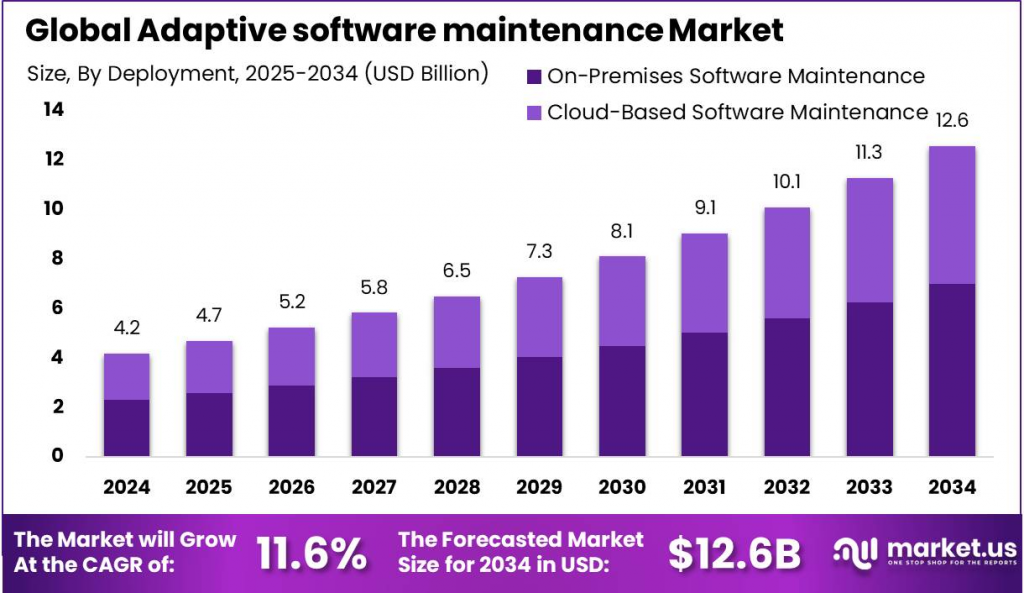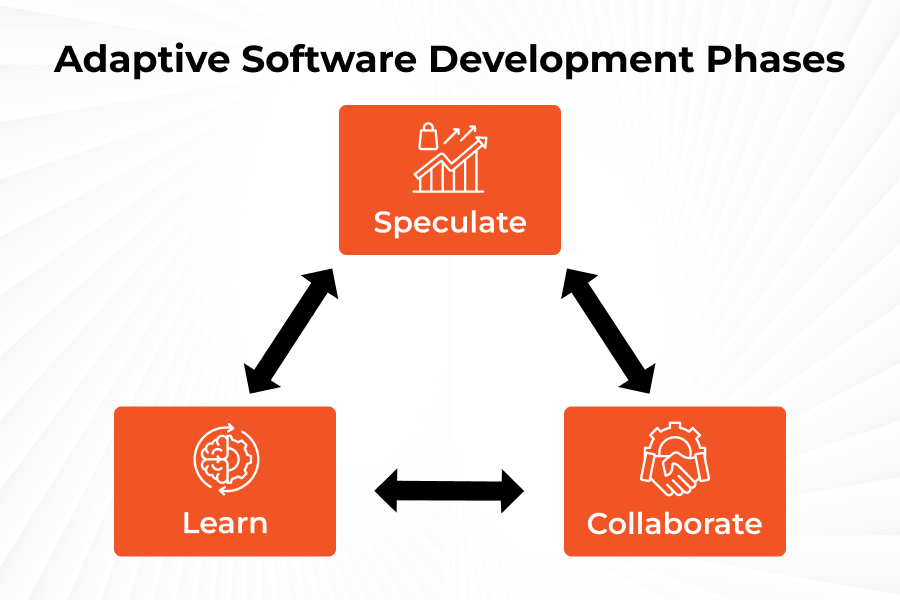In 2025, the software industry is experiencing a dynamic shift. AI, blockchain, quantum computing, etc, all of these technologies are changing the ways we build software products.
The requirement for building software is evolving at breakneck speed. Old traditional methods like waterfalls, which have rigid structures and predefined sequences, are failing to fulfill market demands. Users want more flexibility and product improvements in less time.
Adaptive Software Development can solve this issue. But what exactly is it?
ASD Software Development is an iterative methodology designed to handle uncertainties. It iterates, learn, and improves without affecting quality.
Jim Highsmith, an American author and software engineer originated this concept in the 1990s. In his career, he improved many software development methodologies.
Adaptive Software Development is an agile methodology that follows no strict rules or steps. More than 92% of tech companies are embracing agile to boost product iterations. In 2025, the need for fast iterations and improvement in products is becoming very crucial. This is increasing the importance of Adaptive Software Development in Software Engineering.

AI solutions and no-code tools are even pushing product development on a rapid scale.
In this fast-moving world, product teams need to build products that are not only functional but also can scale, adapt, and improve with time.
In this blog, we will understand what ASD is, its core principles, pros and cons, best practices, and more. Let’s dive in.
Table of Contents
The Origins and Evolution of ASD Software Development
ASD Software Development came into existence when traditional methods like waterfall were becoming unavoidable. Jim Highsmith and Sam Bayer worked and introduced Rapid Application Development (RAD). They figured that RAD is good with speed, but lacks flexibility in complex systems. To resolve this issue, they introduced the next version of RAD as Adaptive Software Development in the mid-1990s.
In 2000, Jim Highsmith published a seminal book, Adaptive Software Development: A Collaborative Approach to Managing Complex Systems. The book then became the foundation for agile development. After one year, he co-authored the Agile Manifesto, which describes the core principles of ASD in modern software development.
ASD focuses on iteration, feature delivery and active collaboration of stakeholders. Scrum and Kanban popularised these ideas before, and ASD maintained continuous learning and adaptation as components of software success.
ASD is not as popular as Scrum, but it is mainly suited for teams working on complex and heavy systems where experimentation and improvements are critical.
What is Adaptive Software Development (ASD)?
Adaptive software development is an agile methodology that tackles uncertainties in software development. The ASD methodology is not linear. It does not ignore unpredictability; it accepts and embraces it. The development phases are managed into short and iterative cycles where teams can collaborate and suggest changes. Each and every step in ASD is part of a feedback loop. This allows a faster response to evolving requirements.
Key Features
- Iterative and Feature oriented: The development is organized into short and time-bound cycles, delivering practical functionality to end users.
- Mission-Driven: Teams have bigger objectives and outcomes; they are not confined by rigid scope.
- Stakeholder Involvement: In traditional methods, teams work in an isolated manner. But here in the case of ASD, customers and all stakeholders are actively collaborating in the development process. The team works in a cross-functional manner. This ensures real-time feedback, quick iteration, and easy communication.
- Continuous Learning: Reviewing the cycles after each iteration results in a better understanding of product features and customer evolving demands.
- Risk-Driven: To avoid the uncertainties, high-risk tasks are resolved at the initial stage. This helps the team identify major issues before they even escalate.
Traditional methods for development have too much planning and documentation. This results in slow iterative cycles, slow growth, and inefficiencies. In contrast, Adaptive Software Development constantly delivers value to end users and better ROI for all stakeholders.
Adaptive Software Development Methodology and Its Core Principles

ASD simply is built for fast, continuous learning and adapting relentlessly. Here are elementary principles for a successful ASD implementation:
1. Speculate, Collaborate, Learn
The core of ASD lies in a dynamic and iterative cycle replacing traditional linear processes like design, build, and test.
- Speculate basically involves envisioning the solution. Speculation is highly flexible and data-driven.
- Collaborate is where teams, stakeholders, and users all work together closely to bring the best planning and solution with development, user testing, and feedback.
- Learn in ASD replaces traditional ways of reviewing, planning, and documenting. It is all about data-driven reflections. The insights change the next cycle and the next, and so on.
2. Adaptive Planning
We all tend to avoid change in our daily lives. However, in Adaptive Software Development (ASD), teams treat change as inevitable and actively embrace it. Rather than resisting, they build upon it. Instead of using plans as rigid blueprints, they continuously update them with new information. From the outset, teams conduct minimal planning—just enough to initiate execution.
As each execution phase unfolds, it introduces new insights and shifts in direction, which in turn reshape the original plan. Consequently, this approach highlights the core principle of adaptive planning over predictive planning.
This method allows easy pivots during any change or uncertainty. This is also called Rolling Wave Planning.
3. Mission and Value-Driven Execution
Traditional ways include a fixed set of requirements, features that can be valuable or may not. The ASD teams are mission and value-driven. Each feature they build is aligned with the core mission and vision of the product.
This approach in ASD Software Development ensures that teams do not waste their time on low-impact features. At every stage, they begin with a question – “Is this going to fulfill our mission or not?”
4. Time-Boxing and Incremental Delivery
Teams work within tight deadlines by following time-boxed iterations that typically last one to four weeks. During each iteration, they deliver concrete, measurable outcomes. If a task cannot be completed within the set timeframe, they defer it to maintain pace. As a result, this approach ensures timely delivery, sustains the team’s momentum, and strengthens stakeholders’ trust.
5. Collaboration and Self-Organizing Teams
There is no command, authority, or office politics at work. Based on ASD values, teams including all developers, testers, and end-users collaborate and work in close alignment. Those who make decisions are very close to the work and truly understand its ups and downs.
Without open communication and trust, the cycle breaks down. With ASD, the team must be strong with values and a work ethic.
6. Continuous Learning and Feedback-Driven Adaptation
With ASD, every step is a learning experience. Planning and feedback are not just procedural. They are very integrated. The team evaluates what worked and what did not, and uses all insights to evolve the process and the product.
Teams treat every outcome—whether it’s a failure, quality issue, or success—as a valuable learning opportunity. They embrace the concept of “fail fast, learn fast,” which encourages rapid experimentation and continuous improvement.
7. Risk-Driven Development and Change Tolerance
In most of the traditional methods, risks are avoided or postponed. With ASD, high-risk tasks are addressed first in the development process. This eliminates the fear of future surprises and allows time for validation.
8. Just Enough Process and Documentation
The documentations are kept very lean with user stories, design, and diagrams. With ASD, the focus is more on building software and face-to-face communication.
All the critical information is stored in the docs. The goal is to avoid waste and keep relevant content only.
Adaptive Software Development (ASD) Life Cycle
The ASD Mantra is quite simple: Speculate → Collaborate → Learn. The cycle supports cross-functional team involvement, rapid prototyping, and a strategic approach.

Phase 1: Speculate
The goal of speculation is to define the direction for iterative progress. It doesn’t define all requirements upfront like in the traditional methods. In speculation:
- A mission statement is defined with macro objectives.
- Planning is very minimal, just enough to begin the development.
- Teams plan with uncertainties, the focus is on defining boundaries and assumptions, understanding that requirements may change after iterations.
Phase 2: Collaborate
Teams collaborate actively to iterate faster and better. Collaboration is not just internal; it includes end users, domain experts, and all other stakeholders.
- This phase is when real execution happens, the outcomes are delivered in one to four weeks of the cycle.
- Daily stand-up meetings, ongoing reviews, and open discussion are a must.
Phase 3: Learn
Learning is not a formality. It is important and not optional. To improve the iteration quality and product market fit, learning is crucial.
- After each cycle, teams have retrospectives and user testing to validate the outcomes.
- Cycle time, number of bugs, NPS score, and all other metrics are analyzed to understand user experience.
Adaptive Software Development Framework vs Traditional Development Models
Adaptive Software Development stands out from traditional models like Waterfall. Here is a breakdown to understand it better:
| Key Aspect | Adaptive Software Development | Waterfall Model |
| Planning Approach | iterative and adaptive; evolves with each cycle. | Upfront planning, fixed scope and timelines. |
| User Involvement | Continuous involvement; stakeholders participate in each cycle. | Limited to early requirements and late acceptance phases. |
| Handling Change | Change is welcomed; scope adapts iteratively. | Change is discouraged; requires formal change control. |
| Delivery Approach | Feature-based, incremental delivery per iteration. | Single, final delivery after all phases are complete. |
| Team Dynamics | Collaborative, self-organizing teams. | Hierarchical, manager-driven structure. |
| Risk Management | Risk-driven development; high-risk features addressed early. | Risks identified early but often addressed late in testing or deployment phases. |
| Feedback Loop | Fast and constant; feedback fuels planning and execution. | Slow; often discovered after deployment. |
| Documentation | Just-in-time and lightweight; focused on current iteration needs. | Exhaustive and upfront; becomes outdated as requirements evolve. |
ASD Software Development thrives in fast-paced product ecosystems, where customer needs change frequently. In contrast, Waterfall is better for stable projects.

Advantages and Disadvantages of Adaptive Software Development
Advantages
1. Embraces Change
Change is obvious in any product development process. ASD is a strong choice for Software Development Services operating in rapidly changing customer needs.
2. Continuous Value Delivery
Each cycle delivers value. This helps stakeholders start seeing ROI very early.
3. Higher User Satisfaction
Continuous feedback and reviews ensure that the end product aligns with user needs.
4. Risk Mitigation Through Iteration
Handling risky features early and testing ensures that issues are captured before they escalate.
5. Fosters Innovation
ASD cultivates an environment of rapid experimentation and encourages teams to fail fast and learn fast.
6. Supports Autonomy and Morale
Every team member is accountable for their work. They are self-organized and make decisions. The ownership of work boosts morale and confidence among team members.
Disadvantages
1. Requires Active Stakeholder Engagement
In general, stakeholders have a very busy schedule. Their input is crucial; if they do not invest enough time in development, iterations lose direction or misalign with goals.
2. Less Predictability
The nature of the ASD model makes it difficult to predict outcomes, scope, and maintain a budget.
3. Potential for Scope Creep
Unforeseen circumstances or changes in requirements lead to more work and diversion from the original goal.
4. Documentation May Suffer
ASD is more focused on execution instead of paperwork. This makes important points remain undocumented, posing compliance challenges.
5. Need for Experienced Talent
Not everyone can take ownership of work and have self-discipline. Adaptive software development in software engineering can result in misalignment if the team is not mature.
6. Integration with Traditional Structures Can Be Tough
All team members should practice agile methodology. Anyone following Waterfall, can lead to communication gaps and eventually slow down the process.
Understanding these pros and cons can help product teams make informed decisions. For projects involving Custom Enterprise Software Development, ASD can be transformative if the resources are well provided.
Best Practices for Successful ASD Implementation
1. Start with a Pilot Project
Start small. With product features, requirements are always expected to evolve. This minimizes the risk and lets you iterate quickly.
2. Build a Culture of Trust
Trust is the foundation for everything you do. Having a better team is always undervalued in the corporate world. Build a safe culture to experiment, report failures, and collaborate.
3. Timebox Everything
Set deadlines for each and every project. Iterations, planning, and all other activities must be constrained by time. This encourages more focus and discourages perfectionism among team members.
4. Maintain a Living Backlog
Keep the backlog lean, prioritized, and adaptive.
5. Involve Stakeholders Frequently
Have consistent demos and feedback. Stakeholders should be involved throughout the development cycle.
6. Automate Testing
Use tools like Jenkins and Selenium to ensure the quality improves with each cycle.
7. Prioritize Risky Features Early
Handle high-risk features early in the development phase. This reduces the chances of major rework in the future.
8. Use Lightweight Documentation
Ensure the documentation has all key decisions, APIs, and all other key important points. Keep the documentation neat and very light, just enough to enable onboarding and compliance.
9. Measure What Matters
Measure metrics such as iteration speed, test coverage, feature usage, and user satisfaction. These metrics provide a complete picture of the team, users, and the product.
These practices are essential to follow for companies providing Software Development Consulting Services.

Tools and Techniques Supporting ASD in Software Engineering
1. Agile Project Management Tools
There are tools like Jira, Azure DevOps, Asana, and Trello for managing user stories and workflows. These tools support iterations, open communications and feedback, all of which are key tenets of ASD Software Development.
2. Continuous Integration & Delivery (CI/CD)
CI/CD pipelines ensure automated feedback. Use tools like GitHub Actions, Jenkins, and CircleCI to automate tests and deployments.
3. Version Control & Collaboration
Platforms like GitHub and GitLab allow teams to code together, integrating issue tracking and pull request workflows that support peer reviews, enhancing the quality of code.
4. Team and Knowledge Sharing
There are many platforms for team collaboration like Slack, Zoom, and Teams from Microsoft. For documentation, Notion gives structured knowledge that obeys the ASD approach.
5. Automated Testing and Quality Assurance
Tools like Selenium, Postman, and Cypress support testing for functions, regression, and APIs. These tools help in each cycle of Adaptive Software Development in Software Engineering.
6. Visualization and Whiteboarding
Miro and draw.io support collaborative design during the initial phase of development. These tools help teams to visualize data flows and workflows.
Together, these tools support and follow the nature of ASD Software Development.
Future Trends in Adaptive Software Development
1. AI-Augmented Planning and Testing
AI can speed up the development cycle to a great extent. Test cases, documentation, and planning can be autogenerated, saving time and costs.
2. Integration with DevOps and Platform Engineering
With DevOps, ASD can create an ecosystem where planning, deployment and monitoring are done seamlessly.
3. Product-Centric Adaptive Teams
Companies are preferring product centric teams more compared to project-based teams. These teams iterate fast and deliver on time.
4. Business-Wide Agility
Companies are using adaptive frameworks for operational and strategic planning. ASD is not limited to IT. It is being accepted in other areas like HR and Finance.
5. Sustainability and Resilience
Sustainability and Resilience are the main priorities as the system becomes more complex. ASD includes resilience testing (e.g., chaos engineering) to identify system weaknesses.
Final Thoughts: Adaptive Software Development
Adaptive Software Development is a robust strategy for handling uncertainty in software development. With AI, the user needs, tech and business models are evolving way faster than before. To sustain in a competitive environment, ASD equips teams to keep up the pace. ASD fosters innovation and growth when implemented thoughtfully.
Thinking About Shifting to Adaptive Software Development (ASD)?
We at A3Logics have spent nearly 21 years helping organizations implement ASD. With a seasoned group of 350+ tech experts, we are here to offer practical and thoughtful support.
Whether you are refining an existing workflow or building something new from scratch.
Connect with us today!






